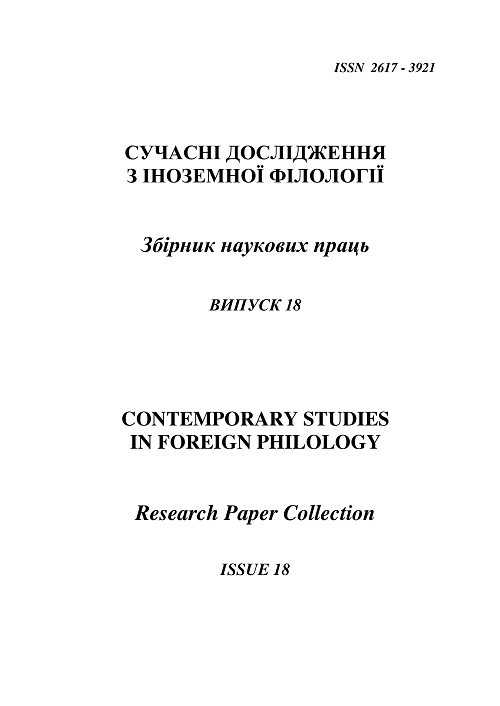Non-verbal means denoting aggression in Modern English
DOI:
https://doi.org/10.24144/2617-3921.2020.18.197-207Анотація
The paper is devoted to the verbalization of aggressive human states in English texts of fiction. Aggressive states and aggressive behavior of the individual is one of the most important social problems. The question of the relationship between verbal and nonverbal in aggression is complex and multifaceted. It includes such problems as the definition of emotions stimulating aggression, the actual act of aggression and emotional states that arise as a result of an aggressive act. Some of these questions can be answered in the process of linguistic analysis of literary texts. Texts of fiction are a repository of emotional experience of mankind. They reflect the stereotyped ideas of native speakers about the nonverbal manifestation of certain emotions in a given culture, including emotions - components of aggressive states. Verbalizations of emotions in literary texts are much more informative than in living spoken language, because they are a stylized representation of ideas about how an emotion should be expressed. The means of describing aggressive states thus contain information about the emotions that stimulate aggression. It follows that aggression is a physical (including verbal) act, behavior that is stimulated and supported by the emotions of the hostility complex, which, in turn, includes the emotions of anger, disgust and contempt. The next task, solved in the process of research, was to identify lexical and grammatical tools that served to describe the aggressive states of man in English. It was found that the reflection of the emotional state of the speaker in the literary text is carried out through the description of the actual emotional state and through the description of non-verbal and verbal expression of an emotion. The most frequent way to describe emotions was recognized as a lexical description of emotional kines and prosody, which in turn can be explicit and implicit.
Keywords: non-verbal means, aggression, anger; disgust and contempt, gestures, prosody.
Посилання
American Heritage Dictionary online. URL: https://ahdictionary.com/
Argyle M. K. The psychology of interpersonal behavior. Harmondsworth : University Publishing House, 1990. 336 p.
Dunn D. S. Psychology Applied to Modern Life: Adjustment in the 21st Century. London : Cengage Learning, 2010. 48 p.
Ekman P. Facial Expressions. Sussex: John Wiley and sons, 1999. 320 p.
Foer S.J. Extremely Loud and Incredibly Close. London : Homeworth Publishing House, 2004. 328 p.
Gabaldon D. A Breath of Snow and Ashes. London : Gabaldon, 2002. 659 p.
Hogan K. Can You Hear Your Body Talking online. URL: http://www.kevinhogan.com/body-language-detect.htm.
Izard С. Human Emotions. New York : Kensington Publishing House. 1977. 495 p.
Keyes M. Anybody Out There. New York : William Morrow Paperbacks, 2007. 464 p.
Miller G. A. Language and communication. New York : McGraw-Hill, 1951. 298 p.
Основы теории коммуникации : монография / С.И.Абрамов. Москва: Гардарики, 2003. 615 с.
Янова О. А. Інтенсифікація емотивного значення в номінаціях усмішки : монографія. Київ : Логос, 2000. 282 c.
##submission.downloads##
Номер
Розділ
Ліцензія
Автори, які публікуються у цьому журналі, погоджуються з наступними умовами:
- Автори залишають за собою право на авторство своєї роботи та передають журналу право першої публікації цієї роботи на умовах ліцензії Creative Commons Attribution License, котра дозволяє іншим особам вільно розповсюджувати опубліковану роботу з обов'язковим посиланням на авторів оригінальної роботи та першу публікацію роботи у цьому журналі.
- Автори мають право укладати самостійні додаткові угоди щодо неексклюзивного розповсюдження роботи у тому вигляді, в якому вона була опублікована цим журналом (наприклад, розміщувати роботу в електронному сховищі установи або публікувати у складі монографії), за умови збереження посилання на першу публікацію роботи у цьому журналі.
- Політика журналу дозволяє і заохочує розміщення авторами в мережі Інтернет (наприклад, у сховищах установ або на особистих веб-сайтах) рукопису роботи, як до подання цього рукопису до редакції, так і під час його редакційного опрацювання, оскільки це сприяє виникненню продуктивної наукової дискусії та позитивно позначається на оперативності та динаміці цитування опублікованої роботи (див. The Effect of Open Access).

